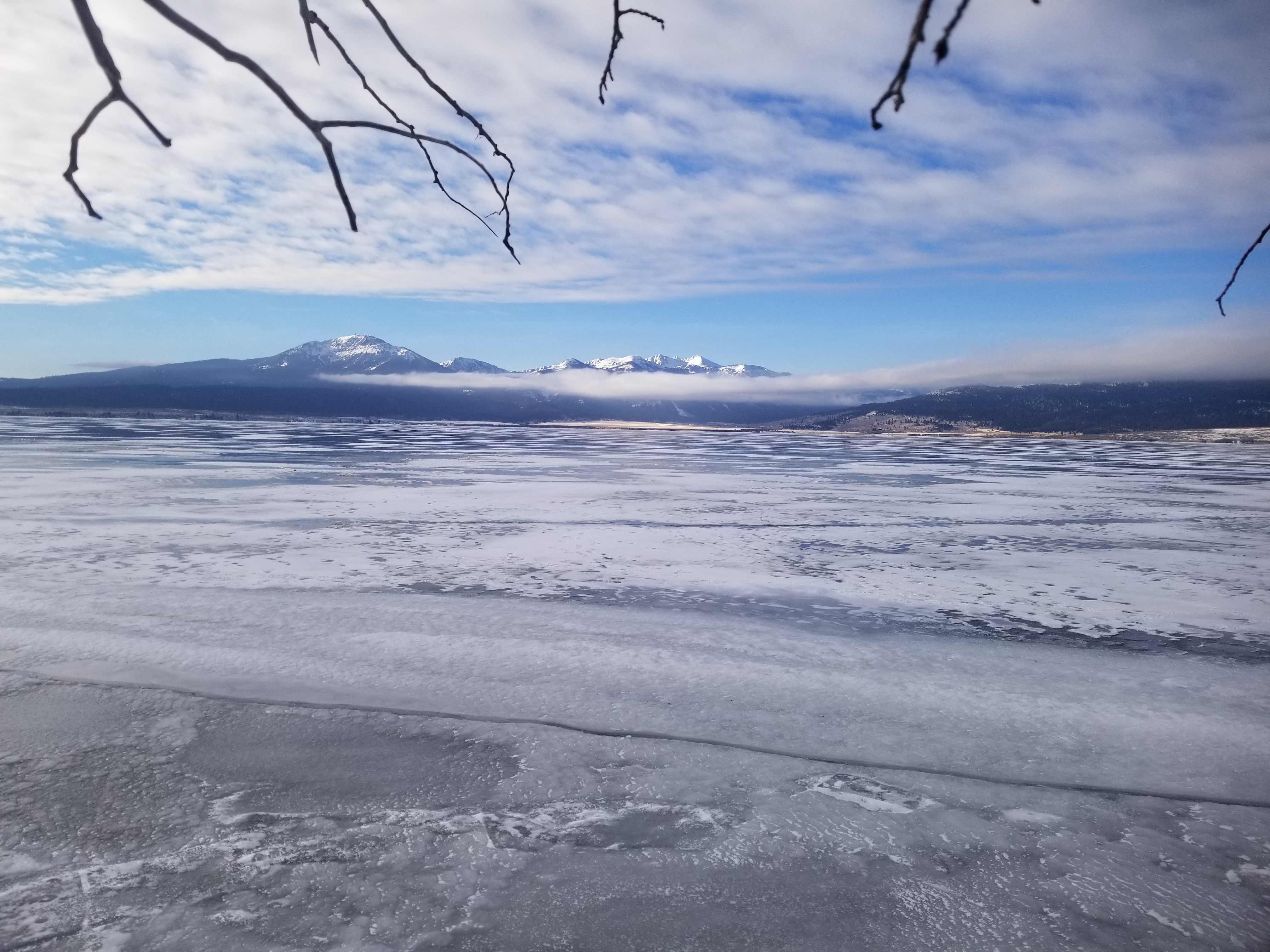Henrys Lake Quarterly Newsletter
December 2019
--Fish Stocking--
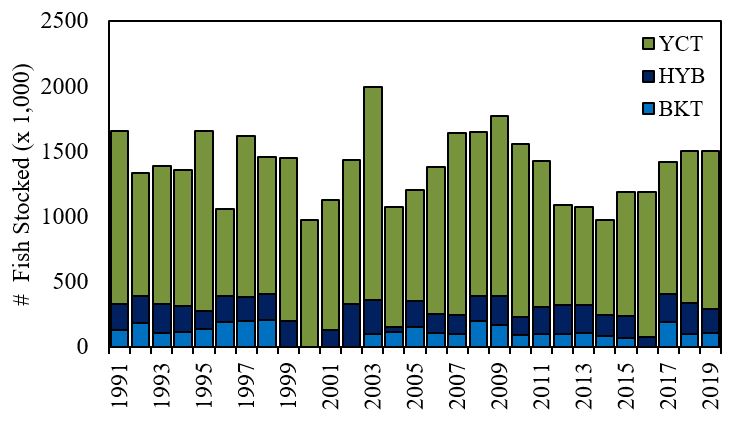
Figure 1: The number of trout by species stocked into Henrys Lake from 1991 to 2019 where YCT= Yellowstone Cutthroat Trout, HYB= Hybrid Trout (Yellowstone Cutthroat x Rainbow Trout), and BKT= Brook Trout.
Each year we stock Henrys Lake with three species of trout. In the years past, we stocked all of our hatchery fish during the last week of September. This year we adjusted this stocking regime. We switched our rearing facility for Hybrid Trout from the Mackay Hatchery to the American Falls Hatchery, where the fish grow faster with higher water temperatures. Due to this, we stocked approximately 171, 765 Hybrid Trout (Rainbow x Yellowstone Cutthroat Trout) on June 10th and 11th 2019, that were ~2.5 inches in length. An additional 18,681 Hybrid Trout at 3.4 inches in length were also stocked on September 30th. All other trout were stocked during the week of September 24. This included 1,209,364 Yellowstone Cutthroat Trout at ~3” in length and 106,289 Brook Trout at ~5” in length.
That’s a total of over 1,506,000 trout!
--Water Quality--
This August marked the one year anniversary of our water quality program on Henrys Lake. A huge thank-you to our partners, the Henry’s Fork Foundation, the Henrys Lake Foundation and the Idaho Department of Environmental Quality for help in making this project a reality. The lower abundances of trout caught during our gillnet surveys from 2015 to 2018 suggest that trout may have experienced a higher than normal mortality rate and some potential factors limiting trout production in the lake may be abiotic factors such as temperature and oxygen.
We collect data on temperature, dissolved oxygen (DO), conductivity (a measure of how much “stuff” is in the water column), and the algal production (tied to the cyanobacteria blooms we’ve observed in recent years) as well as measuring water clarity. We have also been collecting water samples to analyze total Nitrogen and total Phosphorus concentrations.
Even though the lake is currently iced over we are still out measuring the amount of snow, thickness of the ice and taking our readings throughout the water column.
--Temp and Dissolved Oxygen--
Since we began our sampling in August 2018, we have not recorded a water temperature over 20°C/68°F (Figure 2). The lethal limit for trout is ~25°C/77°F. Cooler water temperatures have been a welcomed change from the high temperatures observed in the lake over the last few years, and cooler water can hold more oxygen. The amount of oxygen in water is essential to the growth and survival of aquatic animals. Trout prefer waters with high concentrations of oxygen and we deem a concentration of 5 mg/L or higher to be adequate for trout growth and survival. Throughout the 2018 and 2019 open water seasons, dissolved oxygen concentrations throughout the lake were above 5 mg/L (Figure 3). During the last week of sampling each year before the lake iced over, a concentration of >9 mg/L was observed, indicating highly oxygenated waters heading into the winter. These last 2 years have provided trout with cold, well-oxygenated water throughout the spring, summer, and fall.
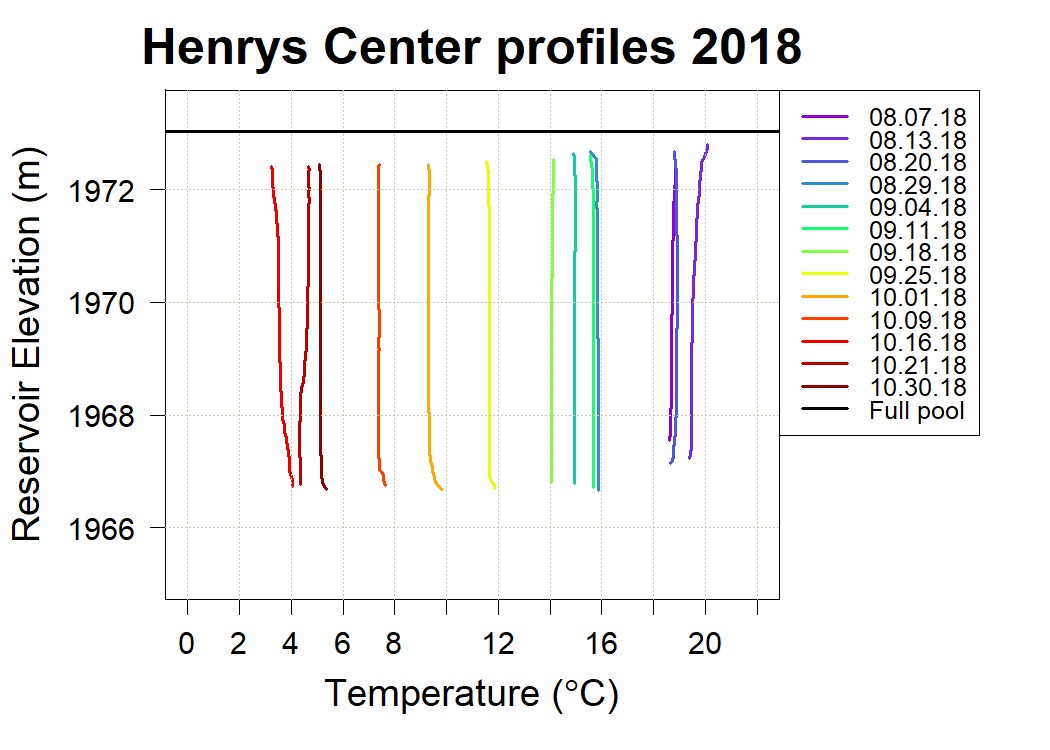
Figure 2a: Temperature (°C) throughout the water column at the Center sampling site during the open water season 2018, Henrys Lake.
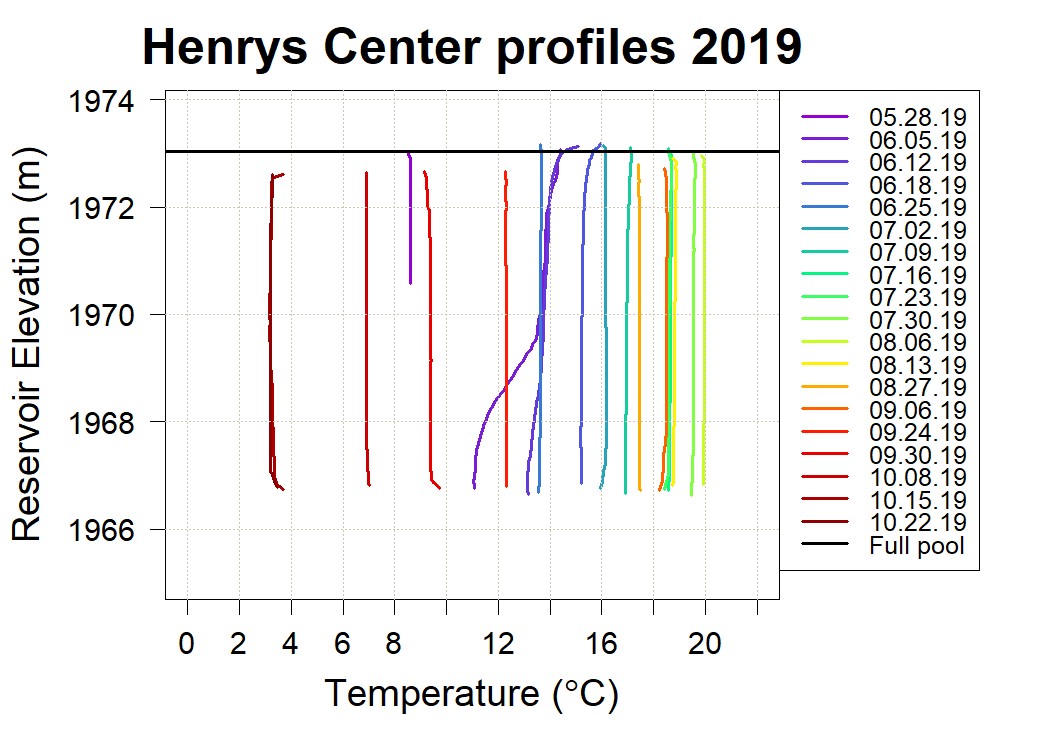
Figure 2b: Temperature (°C) throughout the water column at the Center sampling site during the open water season 2019, Henrys Lake.

Figure 3a: Dissolved oxygen (mg/L) concentrations throughout the water column at the Center sampling site during the open water season 2018, Henrys Lake.
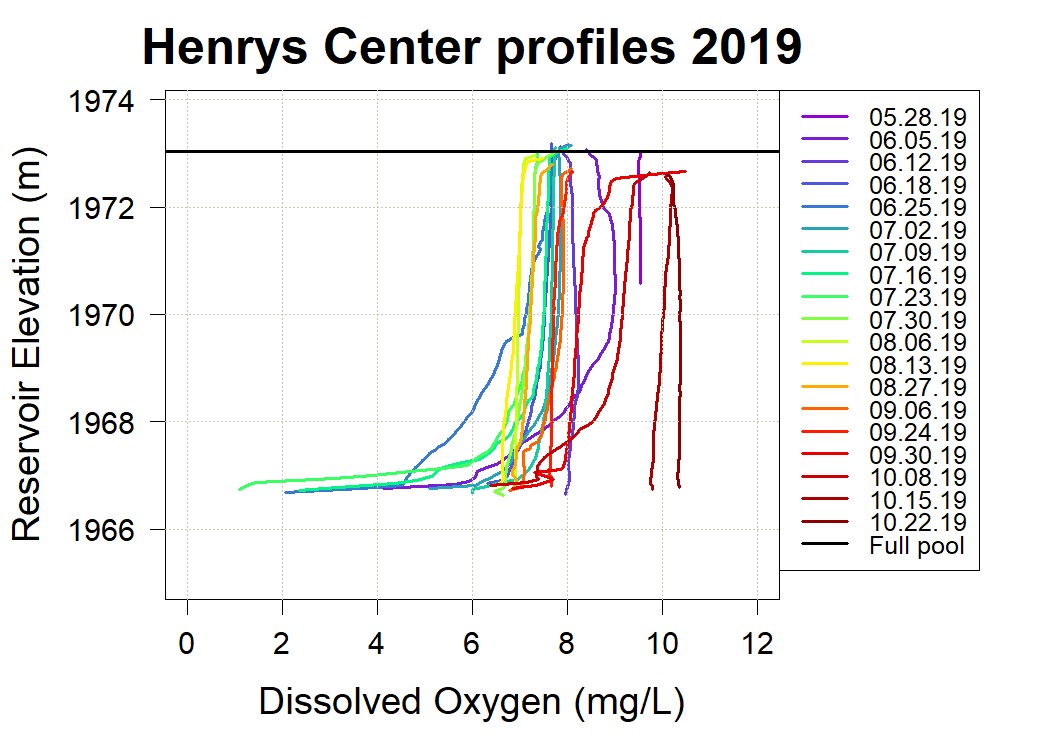
Figure 3b: Dissolved oxygen (mg/L) concentrations throughout the water column at the Center sampling site during the open water season 2019, Henrys Lake.
--Algae--
Algae are important organisms which capture light and undergo photosynthesis and provide an important food source for organisms up the aquatic food chain. As such, algae are essential to the lake and provide oxygen for trout. However, too much algae can indicate issues with water quality, and can be hazardous to plants and animals. To determine the total amount of algae in the water column we can measure different color pigments. The chlorophyll-a pigment gives us a measure of the total amount of algae in the lake and the phycocyanin pigment provides us with the amount of harmful blue-green algae. Both pigments followed the same trend in 2018 and 2019, where algae peaked in the late summer to early fall (Figure 4) and a small harmful algal bloom was recoded at the beginning of October each year (Figure 5).

Figure 4a: Chlorophyll-a (µg/L) concentrations throughout the water column at the Center sampling site during the open water season 2018, Henrys Lake.
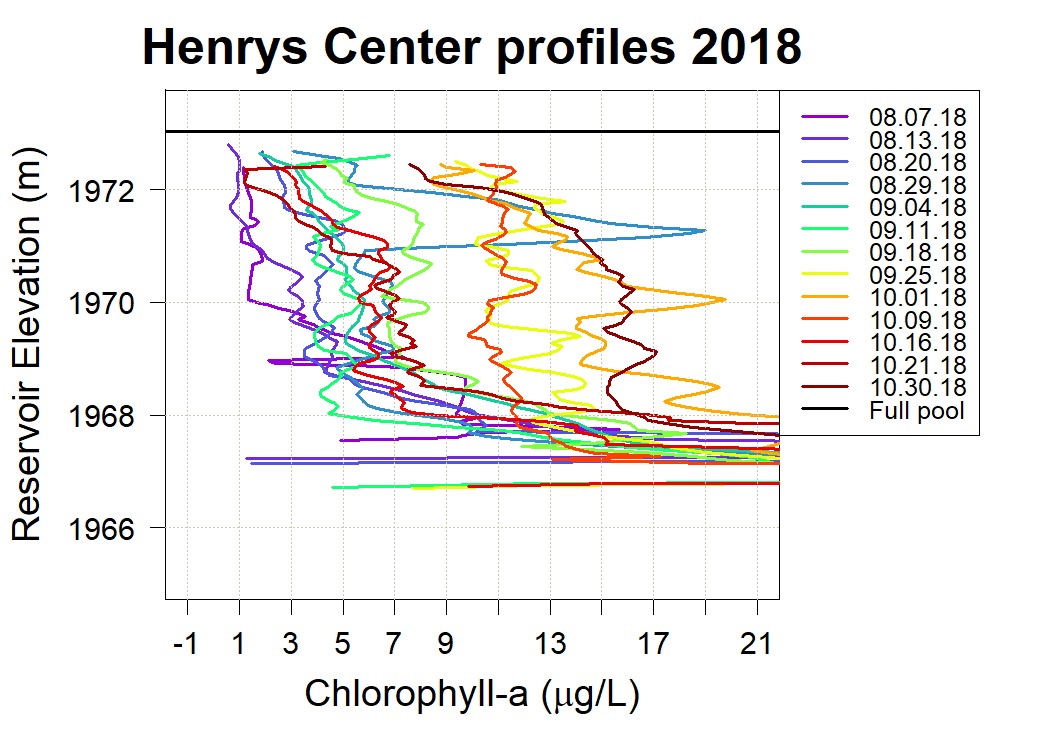
Figure 4b: Chlorophyll-a (µg/L) concentrations throughout the water column at the Center sampling site during the open water season 2019, Henrys Lake.
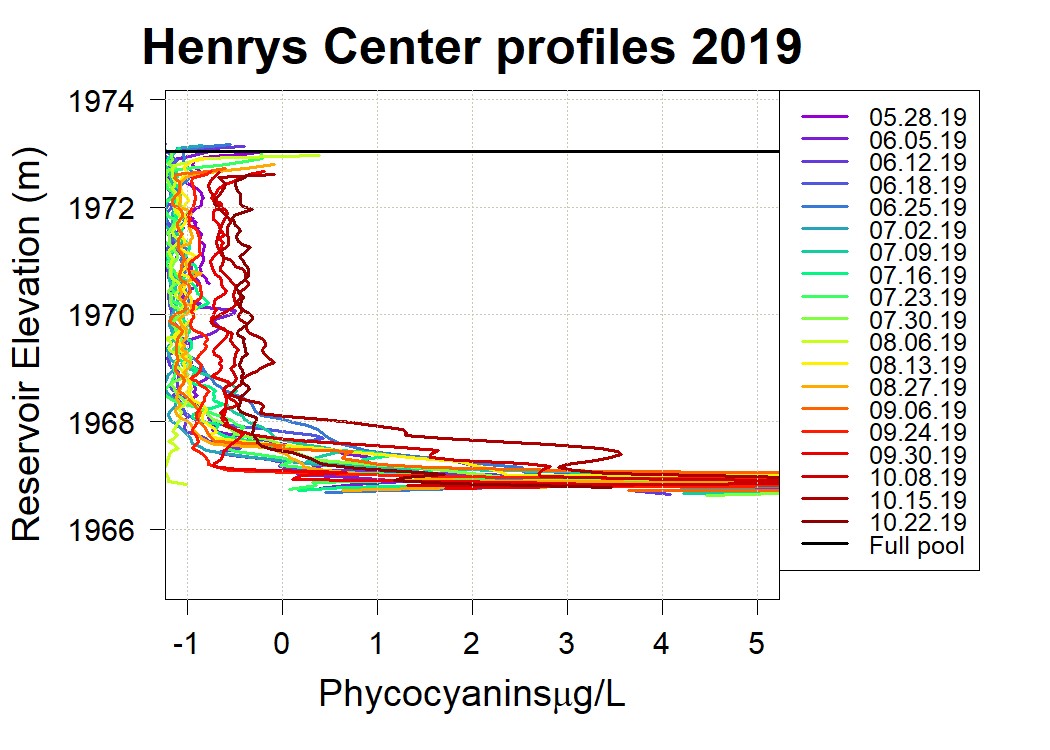
Figure 5a: The concentration of phycocyanis (µg/L) throughout the water column at the Center sampling site during the open water season 2018, Henrys Lake.

Figure 5b: The concentration of phycocyanins (µg/L) throughout the water column at the Center sampling site during the open water season 2019, Henrys Lake.
--Nutrients--
Nitrogen and phosphorus are important nutrients in freshwater lakes. Phytoplankton (algae) production, and subsequently the amount of primary producers in the lake are highly determined by the amount of these nutrients in the water. Total phosphorus concentrations in the water column of freshwater lakes are generally highest during the late summer and early fall with higher temperatures, more sunlight and when primary production is at its peak. Henrys Lake follows this trend throughout the year. Total phosphorus was consistent across all sites providing us with evidence of seasonal internal cycling of phosphorus within the lake instead of an external point source location.
The graph below shows the average nitrogen to phosphorus (N:P) ratio across all sites from August 7th 2018 to October 22nd 2019 (Figure 6). By tracking this ratio we are able to determine if there is a lack of one nutrient which in turn is limiting the growth of primary producers, an important food source for small fry. Throughout the entire year of sampling, the lake appears to be phosphorus limited with the highest limitation occurring in June 2019. Nutrient concentrations and ratios are very similar to those observed in Island Park Reservoir in recent years by the Henry’s Fork Foundation.

Figure 6: The ration of Total Nitrogen to Total Phosphorus measured at the Center sampling site, Henrys Lake once a week from July 8th 2018 to October 22nd 2019.
--Radio Telemetry Graduate Project--
Darcy McCarrick, a graduate student with the Idaho Cooperative Fish and Wildlife Research Unit and the University of Idaho is conducting research on the interaction between Utah Chubs and Yellowstone Cutthroat Trout in Henrys Lake.
The influence of Utah Chub (UTC) on Yellowstone Cutthroat Trout (YCT) is largely unknown, but they typically have negative effects on salmonids in systems where they have been introduced. May 2019 marked the beginning of Darcy’s first field season at Henrys Lake. Fifty UTC and 50 YCT were surgically implanted with radiotelemetry tags between May 28th and June 5th 2019 (Figures 7 and 8).
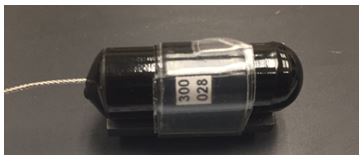
Figure 7: A radio transmitter (tag) which emits a signal that we can detect to determine fish locations.
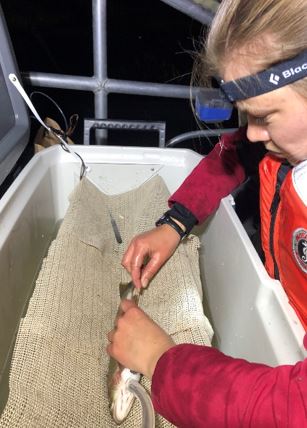
Figure 8: A Yellowstone Cutthroat Trout is surgically implanted with a radio tag.
Fish were relocated via mobile tracking from a boat throughout the summer, and via boat and airplane during fall and winter. Thirty-four YCT and 29 UTC were relocated from June to November 2019. In general, fish were relocated in nearshore habitats (Figure 9). As water temperatures increased, some YCT were observed in the center of the lake in relatively deep water (i.e., > 4 m). We predicted YCT would seek thermal refuge (colder water) at the mouths of tributaries and near springs during peak summer temperatures. A few fish were located in Duck, Howard, and Targhee creeks throughout the summer. However, temperature sensors on the radio tags revealed that the majority of fish were in water temperatures that were similar to the rest of the lake. Habitat assessments were also conducted each time a fish was relocated. These data will be coupled with lake-wide habitat surveys to understand the types of habitat YCT and UTC use. Fish will continue to be relocated throughout the year and ~100 new fish will be radio tagged in spring 2020.
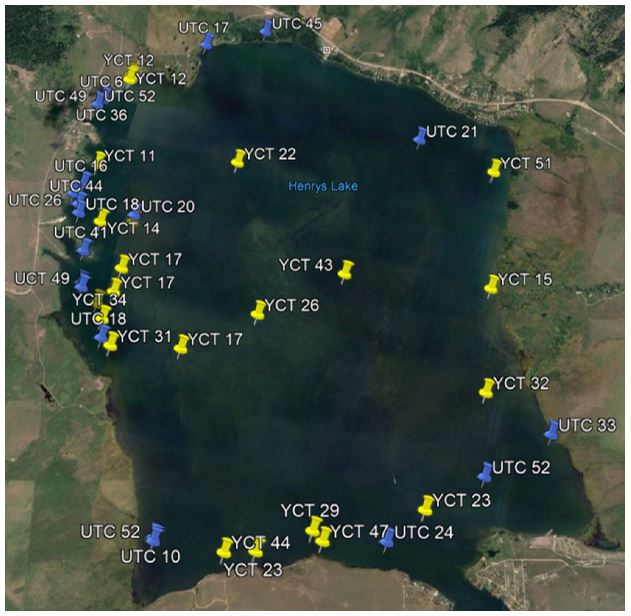
Figure 9: Map of Henrys Lake, Idaho with fish locations sampled in June, July, and August 2019. The yellow markers are Yellowstone Cutthroat Trout and the blue markers are Utah Chub.
--Upcoming January to April--
- 2020 spawn: Each year we spawn Yellowstone Cutthroat Trout and Yellowstone Cutthroat – Rainbow Trout hybrids at Henrys Lake in February and March. We fertilize the eggs and incubate them on site before shipping them to another facility where they will grow into fingerling fry. These fish are then stocked back into the lake in the fall.
- Creel analysis: 2019 marked a full season creel for Henrys Lake. Every three years our staff conduct interviews with anglers and gather information on the entire fishing season. Interviews with anglers provide us with information on the number of hours fished, number and species of fish caught, data from harvested fish in addition to measuring the individual’s level of satisfaction with the fishery. As we are now a few weeks away from the end of the season we will start our analyses this winter and we will provide these results in our next newsletter.
- Gillnetting: Our annual gillnet survey takes place just after ice-off (April/May). Information gathered from this survey allows us to monitor trends in the abundance, size, and age classes of trout and chubs in Henrys Lake.
- Graduate student project: Our graduate student project outlined above will continue on next summer for another year of data collection.
--Ask a Biologist--
At the end of each newsletter we will have a section addressing any questions you may have. Please send any new questions to jenn.vincent@idfg.idaho.gov
Question: Why have I been catching so many 12-16 inch Yellowstone Cutthroat Trout this year?
Answer: A Yellowstone Cutthroat Trout of this size range from Henrys Lake is either a 2 or 3 year old fish. We captured a large number of this size class in our gill nets this year as well. As you can see above in the Henrys Lake stocking graph, we increased stocking of Yellowstone Cutthroat Trout (YCT) in 2016, so it is expected that there are a greater number of age-2 and age 3- YCT on the landscape. Although, this also suggests that we have had high survival rates for our trout over the last several years. There are multiple factors which may have influenced trout survival.
The last two years have been unique years in the Island Park region. The slow release of high mountain snow packs shuttled cold, well oxygenated water into the lake later into the season. In addition, Henrys Lake has not had a notable cyanobacteria harmful algal bloom, often referred to as a blue-green algal bloom since 2016, thus reducing thermal stress on trout during the summer months. Oxygen levels under the ice over the last few years have also been in the range conducive to trout survival.This points to good fishing prospects for years to come.
Our next quarterly newsletter for Henrys Lake will be sent out in April of 2020 so stay tuned!
